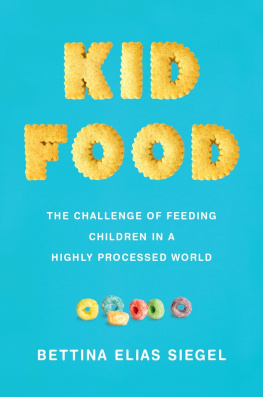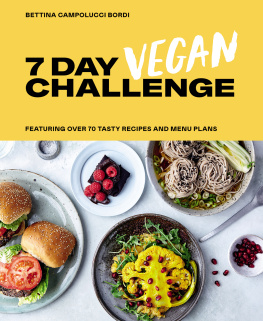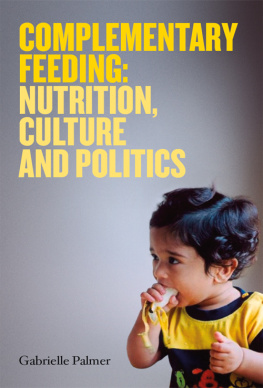Bettina Elias Siegel - The Challenge of Feeding Children in a Highly Processed World
Here you can read online Bettina Elias Siegel - The Challenge of Feeding Children in a Highly Processed World full text of the book (entire story) in english for free. Download pdf and epub, get meaning, cover and reviews about this ebook. year: 2019, publisher: Oxford University Press, genre: Children. Description of the work, (preface) as well as reviews are available. Best literature library LitArk.com created for fans of good reading and offers a wide selection of genres:
Romance novel
Science fiction
Adventure
Detective
Science
History
Home and family
Prose
Art
Politics
Computer
Non-fiction
Religion
Business
Children
Humor
Choose a favorite category and find really read worthwhile books. Enjoy immersion in the world of imagination, feel the emotions of the characters or learn something new for yourself, make an fascinating discovery.
- Book:The Challenge of Feeding Children in a Highly Processed World
- Author:
- Publisher:Oxford University Press
- Genre:
- Year:2019
- Rating:4 / 5
- Favourites:Add to favourites
- Your mark:
- 80
- 1
- 2
- 3
- 4
- 5
The Challenge of Feeding Children in a Highly Processed World: summary, description and annotation
We offer to read an annotation, description, summary or preface (depends on what the author of the book "The Challenge of Feeding Children in a Highly Processed World" wrote himself). If you haven't found the necessary information about the book — write in the comments, we will try to find it.
The Challenge of Feeding Children in a Highly Processed World — read online for free the complete book (whole text) full work
Below is the text of the book, divided by pages. System saving the place of the last page read, allows you to conveniently read the book "The Challenge of Feeding Children in a Highly Processed World" online for free, without having to search again every time where you left off. Put a bookmark, and you can go to the page where you finished reading at any time.
Font size:
Interval:
Bookmark:


Oxford University Press is a department of the University of Oxford. It furthers the Universitys objective of excellence in research, scholarship, and education by publishing worldwide. Oxford is a registered trade mark of Oxford University Press in the UK and certain other countries.
Published in the United States of America by Oxford University Press
198 Madison Avenue, New York, NY 10016, United States of America.
Bettina Elias Siegel 2019
All rights reserved. No part of this publication may be reproduced, stored in a retrieval system, or transmitted, in any form or by any means, without the prior permission in writing of Oxford University Press, or as expressly permitted by law, by license, or under terms agreed with the appropriate reproduction rights organization. Inquiries concerning reproduction outside the scope of the above should be sent to the Rights Department, Oxford University Press, at the address above.
You must not circulate this work in any other form and you must impose this same condition on any acquirer.
Library of Congress Cataloging-in-Publication Data
Names: Siegel, Bettina Elias, author.
Title: Kid food : the challenge of feeding children in a highly processed world / Bettina Elias Siegel.
Description: New York, NY : Oxford University Press, [2020] | Includes bibliographical references and index.
Identifiers: LCCN 2019001198 | ISBN 9780190862121 (hardcover : alk. paper)
ebook ISBN 9780190862145
Subjects: LCSH: ChildrenNutrition. | ChildrenHealth and hygiene.
Classification: LCC RJ206 .S57 2020 | DDC 613.2083dc23 LC record available at https://lccn.loc.gov/2019001198
1 3 5 7 9 8 6 4 2
Printed by Sheridan Books, Inc.
United States of America
for Dana
Throughout this book, I use the term highly processed to describe certain foods and beverages. But what does it mean?
In its PR materials, the food industry tells us that processing is any deliberate change in a food that occurs before its available for us to eat, whether its as simple as freezing or drying food to preserve nutrients and freshness, or as complex as formulating a frozen meal with the right balance of nutrients and ingredients. By defining the term so broadly, the industry can then offer all kinds of reassuring messages, like: most of the food we eat is processed and food processing began about 2 million years ago (referring, I suppose, to fire-roasted wooly mammoth?). The industry and its supporters also like to remind usfrequentlythat even frozen fruit, bagged salad greens, and baby carrots are all processed foods.
Those statements are literally true, and its also true that modern food processing provides all of us with an unprecedented degree of food safety and convenience. We shouldnt discount the importance of those achievements, nor should we romanticize our preindustrial past, when food-borne illness was far more common and when preparing and preserving food was an exhausting, full-time endeavorespecially for women.
At the same time, though, foods most basic purpose is to nourish the body and foster health. If it causes harm, somethings clearly gone off the railsand I think we all know the problem doesnt lie with frozen fruit and baby carrots.
Because the industrys definition of processed food includes both the pear thats been sliced and dried and the unfortunate pear that winds up in a box of Betty Crocker Blastin Berry Hot Colors Fruit Roll-Ups (ingredients: Corn Syrup, Dried Corn Syrup, Pear Pure Concentrate, Palm Oil, Citric Acid, Sodium Citrate, Fruit Pectin, Monoglycerides, Malic Acid, Dextrose, Ascorbic Acid, Acetylated Monodiglycerides, Natural Flavor, and Color [Red 40, Yellows 5 & 6, Blue 1]), I would argue that the term has ceased to have any real meaning. So for the purpose of our discussion here, Ive turned instead to a classification system called NOVA, which was first put forth in 2009 by Dr. Carlos Monteiro, an expert in nutrition and public health at the University of So Paulo in Brazil.
The NOVA system assigns all foods and beverages to four categories, the last of which is ultra-processed. (You can find a description of the other three categories in the endnotes.) Ultra-processed foods and drinks are industrially produced, contain at least five ingredients (but usually many more), andin addition to salt, sugar, and/or fattypically contain industrial additives not commonly found in our kitchens. Sometimes these additives are themselves highly processed, like hydrogenated oils and soy protein isolate. NOVAs examples of ultra-processed foods include mass-produced: sweet and savory snacks; ice cream, candy, and cookies; breakfast cereals; energy bars; pre-made pizza and pasta dishes; poultry and fish nuggets or sticks; burgers; hot dogs; and packaged soups, noodles, and desserts.
When I first read the NOVA definition, though, I was actually inclined to reject it because it seemed to reflect a certain distasteful food snobbery. Like, why is a carton of mass-produced vanilla ice cream considered an ultra-processed food (with all of that terms negative connotations) while a batch of homemade vanilla ice cream is merely processed? After all, a few industrial additives likely make little difference to our bodies, and in the case of some mass-produced vanilla ice creams, such as Hagen-Dazss, the products ingredient listing reads like a recipe we might use in our own homes: cream, skim milk, sugar, egg yolks, and vanilla.
But when I read further, I learned that the NOVA system builds into its definition of ultra-processed food a number of external factors that clearly do make a difference to our bodies, by pushing us toward overconsumption of less healthy food while luring us away from healthier, whole foods. Specifically, in discussing ultra-processed food, the NOVA team includes this statement:
The main purpose of industrial ultra-processing is to create products that are ready to eat, to drink or to heat, liable to replace both unprocessed or minimally processed foods that are naturally ready to consume, such as fruits and nuts, milk and water, and freshly prepared drinks, dishes, desserts, and meals. Common attributes of ultra-processed products are hyper-palatability, sophisticated and attractive packaging, multimedia and other aggressive marketing to children and adolescents, health claims, high profitability, and branding and ownership by transnational corporations.
In other words, what makes the mass-produced vanilla ice cream problematic is the very ease with which we can buy it cheaply and consume it in great quantity, and the degree to which were encouraged to do so by a constant barrage of sophisticated and aggressive marketing. None of that is true of homemade ice cream, which takes time and planning to makeprecisely why so few people ever undertake the project, even when they actually have an ice cream maker languishing in their kitchen cabinets. Most mass-produced foods are also hyper-palatable, as the NOVA team notes, meaning their flavor and texture have been carefully calibrated to make them extremely pleasurable to eatso pleasurable that some experts believe theyre actually addictive, or at least potentially so.
In this way, the NOVA definition of ultra-processed food squares nicely with one of food writer Michael Pollans most oft-repeated Food Rules: Eat all the junk food you want as long as you cook it yourself.
Font size:
Interval:
Bookmark:
Similar books «The Challenge of Feeding Children in a Highly Processed World»
Look at similar books to The Challenge of Feeding Children in a Highly Processed World. We have selected literature similar in name and meaning in the hope of providing readers with more options to find new, interesting, not yet read works.
Discussion, reviews of the book The Challenge of Feeding Children in a Highly Processed World and just readers' own opinions. Leave your comments, write what you think about the work, its meaning or the main characters. Specify what exactly you liked and what you didn't like, and why you think so.











